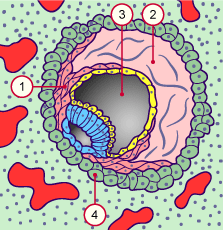
1
2
3
4 |
Extra-embryonic mesoblast
Extra-embryonic reticulum
Primary umbilical vesicle
Cytotrophoblast |
|
|
|

5
6
7
|
Lacunae in the reticulum
Hypoblast
Heuser´s membrane between hypoblast and mesoblast cells |
|
|
|
Fig. 9, Fig. 10
Extra-embryonic mesoblast cells, derived from epiblast cells, grow into the extra-embryonic reticulum. Beginning of the reticular vacuole formation that will form the future chorionic cavity.
|

